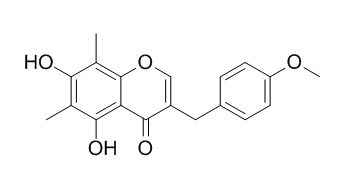Methylophiopogonone B
Methylophiopogonone B is a natural product from Ophiopogon japonicus.
Inquire / Order:
manager@chemfaces.com
Technical Inquiries:
service@chemfaces.com
Tel:
+86-27-84237783
Fax:
+86-27-84254680
Address:
1 Building, No. 83, CheCheng Rd., Wuhan Economic and Technological Development Zone, Wuhan, Hubei 430056, PRC
Providing storage is as stated on the product vial and the vial is kept tightly sealed, the product can be stored for up to
24 months(2-8C).
Wherever possible, you should prepare and use solutions on the same day. However, if you need to make up stock solutions in advance, we recommend that you store the solution as aliquots in tightly sealed vials at -20C. Generally, these will be useable for up to two weeks. Before use, and prior to opening the vial we recommend that you allow your product to equilibrate to room temperature for at least 1 hour.
Need more advice on solubility, usage and handling? Please email to: service@chemfaces.com
The packaging of the product may have turned upside down during transportation, resulting in the natural compounds adhering to the neck or cap of the vial. take the vial out of its packaging and gently shake to let the compounds fall to the bottom of the vial. for liquid products, centrifuge at 200-500 RPM to gather the liquid at the bottom of the vial. try to avoid loss or contamination during handling.
Chemistry of Natural Compounds2018, 204-206
Journal of Ginseng Research2023, 12.004.
Front Microbiol.2020, 11:583594.
Food Quality and Safety2018, 2:213-219
Food Chem.2020, 332:127412
Pharmaceuticals (Basel).2024, 17(6):727.
British Jou. Med.&Med. Research2014, 1802-1811
Chemistry of Natural Compounds2019, 55(1):127-130
Korean J. Medicinal Crop Sci2021, 10:345-352.
Microchemical Journal2022, 182: 107874.
Related and Featured Products
Zhongguo yao xue za zhi,2005,40(5):337-341.
Studies on the liposoluble components from tuber of Ophiopogon japonicus.[Reference:
WebLink]
METHODS AND RESULTS:
The compounds were isolated by column chromatography with silica gel and Sephadex LH-20 and the structures were elucidated by spectras' analysis. Sixteen compounds were obtained as 7 homoisoflavones, 2 anthraquinones, 3 phenolic acids, 2 terpenes and 2 fatty acids. Their structures were identified as methylophiopogonanone A(I), methylophiopogonanone B(II), methylophiopogonone A(III), Methylophiopogonone B(IV), 2'-hydroxy-methylophiopogonone A(V), 6-aldehycto-isoophiopogo-nanone A(VI), 5,7-dihyelroxy-8-methoxy-6-methyl-3-(2'-hydroxy-4'-methoxybenzyl) chroman-4-one(VII), chrysophenol(VIII), emodin(IX), vanillic acid(X), P-hydroxy benzaldenhyde (XI), P-trans-coumarinic acid(XII), l-borneol-#beta#-D-glucopyranoside (XIII), oleanolia acid(XIV), azelaic acid (XV) and n-tricosanoic acid(XVI).
CONCLUSIONS:
The compound IV, VIII--XII and XIV--XVI were isolated from O. japonicus and the genus Ophiopogon for the first time, respectively. The types of anthraquinone, phenolic acid and triterpene were firstly obtained from the genus.



